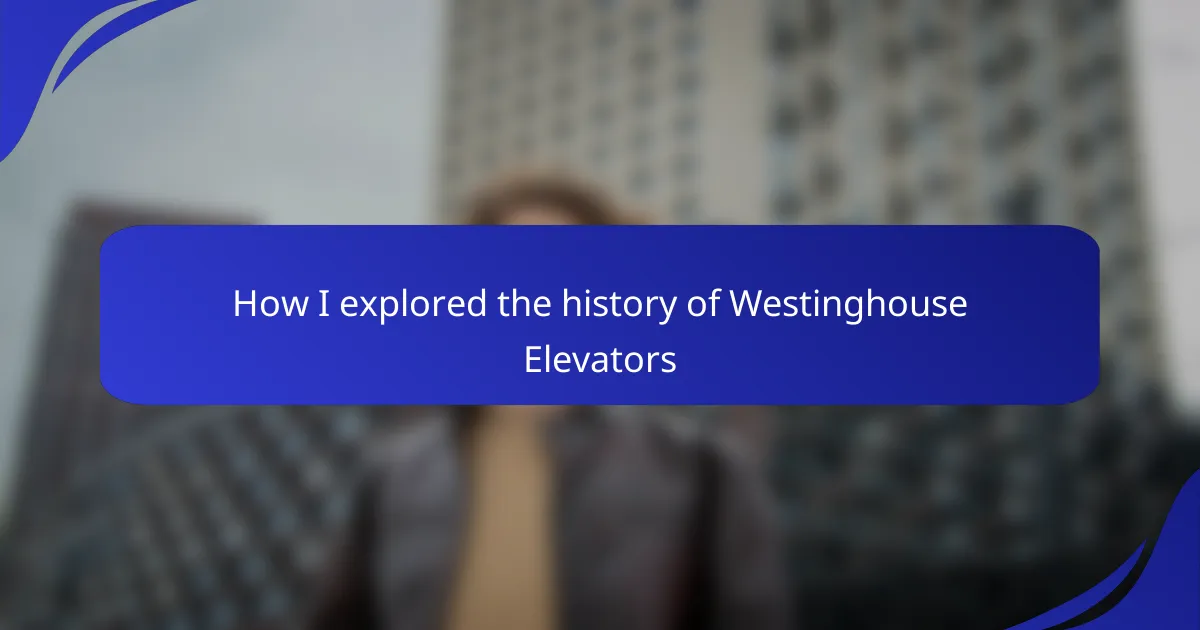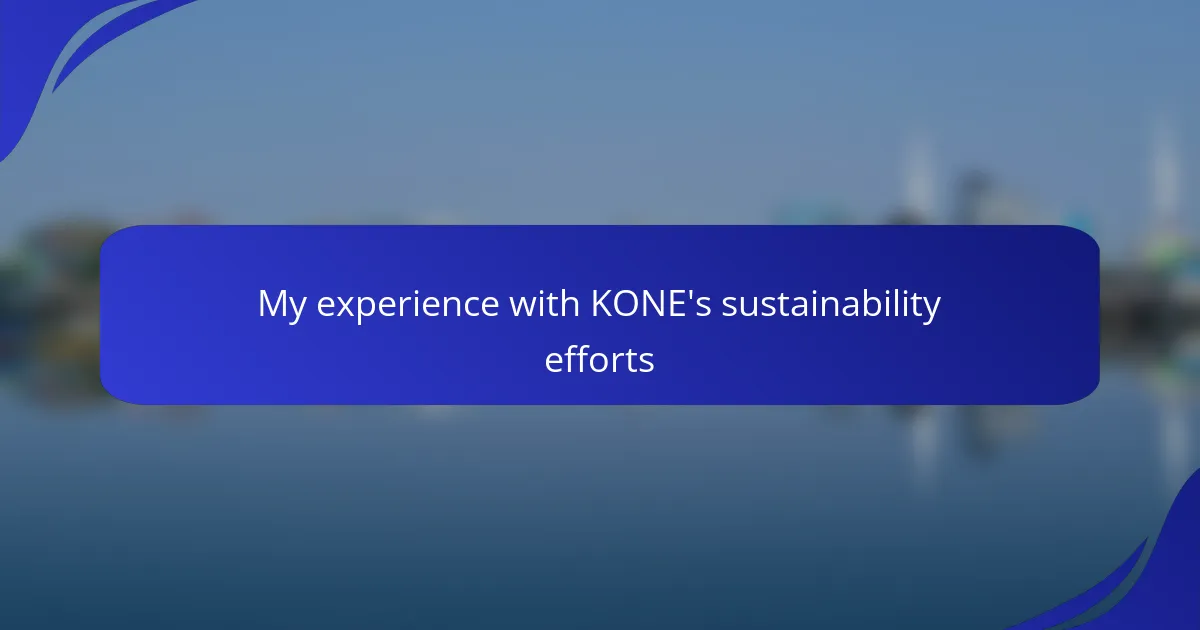Key takeaways
- The elevator industry has evolved significantly from simple lifting devices to sophisticated, safe, and energy-efficient machines crucial for modern urban environments.
- Westinghouse Elevators played a pivotal role in advancing elevator technology, including the introduction of electric traction elevators and automatic operation systems, which reshaped building design and accessibility.
- Understanding the historical context of elevator innovations reveals how societal needs drive technological advancements and enhance user experiences.
- The integration of microprocessor technology in the 1980s marked a significant leap towards smart elevators, highlighting a legacy of safety, efficiency, and improved human interaction with vertical transportation.
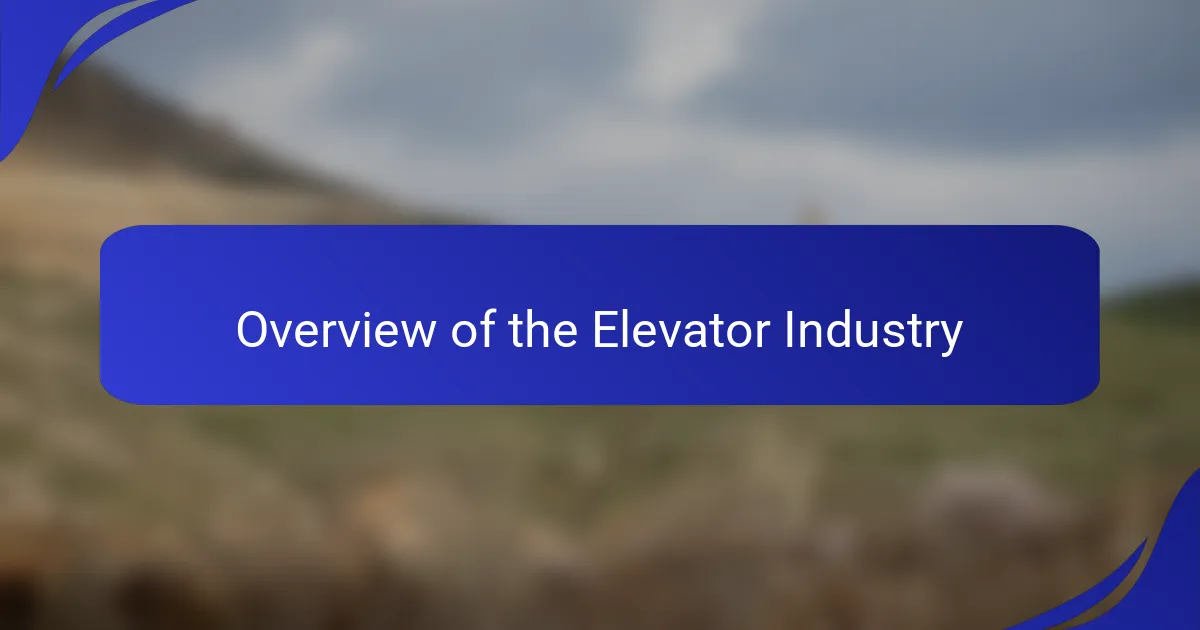
Overview of the elevator industry
The elevator industry has undergone a remarkable transformation since its inception in the early 19th century. I remember standing in awe before an old steam-powered elevator, pondering how far we’ve come; it was a gateway to understanding industrial innovation and societal change. Elevators have evolved from rudimentary lifting devices to sophisticated machines that not only transport us but also shape our urban landscapes.
The elevator industry has several key characteristics that highlight its impact:
- Technological Innovation: From steam-powered mechanisms to cutting-edge smart technology, each advancement has made elevators safer and more efficient.
- Vertical Expansion: As cities grew taller, elevators became essential for reaching new heights, influencing architectural design.
- Safety Standards: Over the years, safety regulations have significantly improved, ensuring that modern elevators are reliable for daily use.
- Environmental Considerations: Today’s designs increasingly focus on energy efficiency and sustainability, reflecting a growing awareness of our ecological footprint.
- Global Reach: Elevators are now integral to buildings worldwide, facilitating accessibility and convenience in urban centers and beyond.
Reflecting on these aspects, it’s clear how elevators are deeply woven into the fabric of modern life, constantly evolving yet rooted in a rich history.
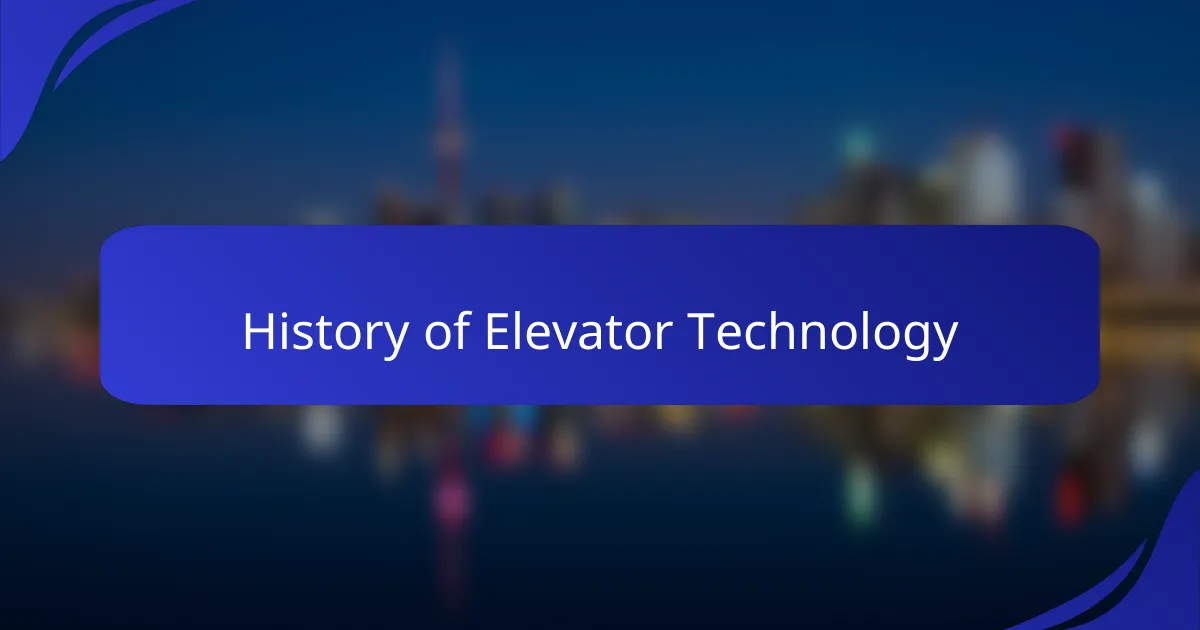
History of elevator technology
The history of elevator technology is fascinating and filled with pivotal moments that changed how we move within buildings. When I first learned about the Otis safety brake in 1853, I was struck by how a simple invention could revolutionize safety in vertical transportation. Imagine descending hundreds of feet in an elevator, trusting a mechanism that ultimately saved countless lives—it adds a whole new layer of appreciation for these machines.
In the late 19th century, advancements like electric elevators made a significant impact on city skylines. I often think about how the integration of electric power opened doors—literally and figuratively—for taller buildings. It’s incredible to realize that what we take for granted today once seemed like science fiction, allowing cities to soar to new heights and reshaping our urban experience.
As I explored further, I discovered the evolution of control systems, shifting from simple pull systems to advanced microprocessor-controlled elevators. This evolution makes me wonder: how much more can technology innovate in the years to come? Each step in this journey illustrates not just technological progress, but also the human desire to connect people and spaces in increasingly efficient ways.
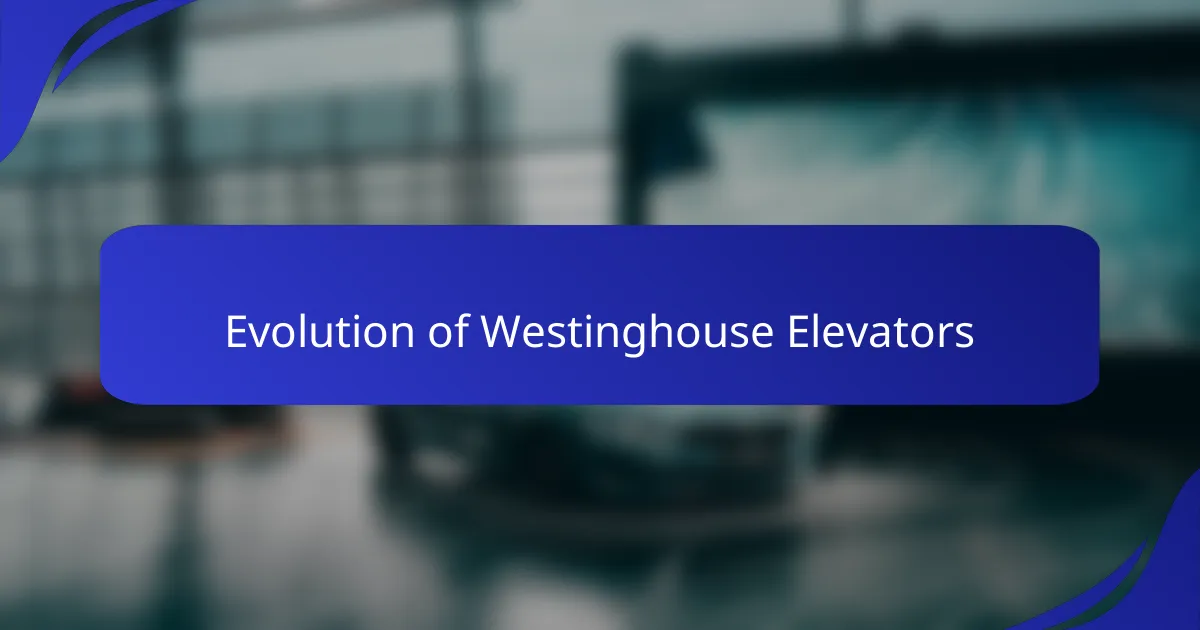
Evolution of Westinghouse Elevators
Exploring the evolution of Westinghouse Elevators has been quite a journey for me. Starting from their early designs in the late 19th century, it’s fascinating to see how innovation has shaped the elevator industry. I remember reading about their revolutionary electric traction elevators, and it struck me how such advancements contributed to the skyline of cities and made buildings more accessible.
As I delved deeper into their history, I noticed the shift in technology over the decades. From steam-powered hoists to more efficient electric systems, Westinghouse has always been at the forefront of industry advancements. This evolution not only reflects technological progress but also highlights the company’s commitment to safety and efficiency. I really appreciate how their innovations have transformed the way people navigate through spaces, merging engineering with everyday experiences.
| Era | Key Developments |
|---|---|
| 1890s | Introduction of electric traction elevators, providing safer and smoother rides. |
| 1920s | Innovations in automatic operation and safety systems, enhancing user convenience. |
| 1980s | Integration of microprocessor technology for better control and energy efficiency. |
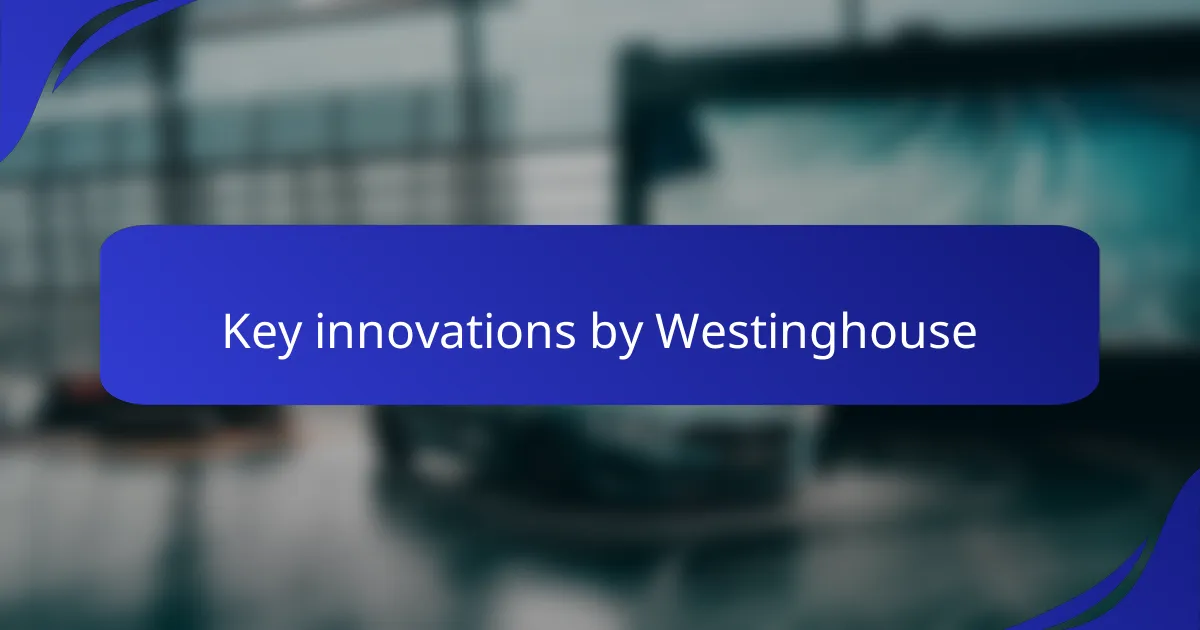
Key innovations by Westinghouse
Westinghouse’s contributions to the elevator industry are truly remarkable, particularly their introduction of electric traction elevators in the 1890s. I remember the first time I experienced one; the smooth ascent was both exhilarating and enlightening. It was a significant leap from older systems, allowing for taller buildings and dramatically altering the urban landscape. Can you imagine that shift?
In the 1920s, Westinghouse further revolutionized how we interact with elevators by pioneering automatic operation and advanced safety systems. This meant no more manually operated controls for users, which I found fascinating. I often imagine rushing into a building, comfortably stepping into an elevator, and knowing the system had been designed for effortless, safe travel—it’s a luxury we often overlook.
The introduction of microprocessor technology in the 1980s was another transformative moment for Westinghouse Elevators. This innovation not only improved control but also enhanced energy efficiency, aligning with the growing focus on sustainability in the industry. Reflecting on how far we’ve come, I can’t help but feel grateful for the minds behind these advancements. Each innovation offered a glimpse into the future of vertical transportation, and it gets me excited to think about what’s next.

Personal journey of discovery
Exploring the history of Westinghouse Elevators has been like embarking on a personal treasure hunt for me. Each step uncovered stories of innovation that felt deeply connected to my own fascination with technology and its evolution. I remember visiting an old Westinghouse lift still in operation; it felt like stepping into a time machine, where I could almost hear the clang of history echoing from its aging metal.
- My first encounter with a vintage Westinghouse Elevator at a local heritage building sparked my curiosity.
- Researching the company’s technological advances gave me a sense of appreciation for the craftsmanship involved in elevator design.
- I experienced a mix of excitement and nostalgia as I compared modern elevators to those from Westinghouse’s pioneering days.
- Discovering how Westinghouse contributed to the safety features we take for granted today was particularly enlightening.
- Each piece of information I uncovered felt like connecting the dots in a larger narrative about progress in the elevator industry.

Lessons learned from the process
The process of exploring the history of Westinghouse Elevators taught me firsthand the importance of context in understanding innovation. I often found myself reflecting on how societal needs shaped technological advancements. For example, the shift from steam to electric elevators wasn’t merely a technical upgrade; it was a response to the growing demand for taller buildings and safer transport. This realization made me appreciate not just the inventions themselves, but also the people behind them.
One key lesson I learned is that progress often involves a blend of creativity and practicality. As I researched, I observed how Westinghouse integrated cutting-edge technology with user-friendly design. I still remember the thrill of discovering how their automatic systems freed users from manual operation, drastically changing the elevator experience. It made me think—how often do we overlook these small conveniences that have become integral to our daily lives?
Lastly, I understand now that every innovation carries a legacy. Learning about the evolution of safety features in Westinghouse elevators was particularly eye-opening. I realized these advancements didn’t just save lives; they built trust in vertical transportation. Reflecting on this, I can’t help but wonder how future innovations will continue to define our interaction with urban spaces. What new connections will we forge as technology evolves? It’s an exciting thought, isn’t it?
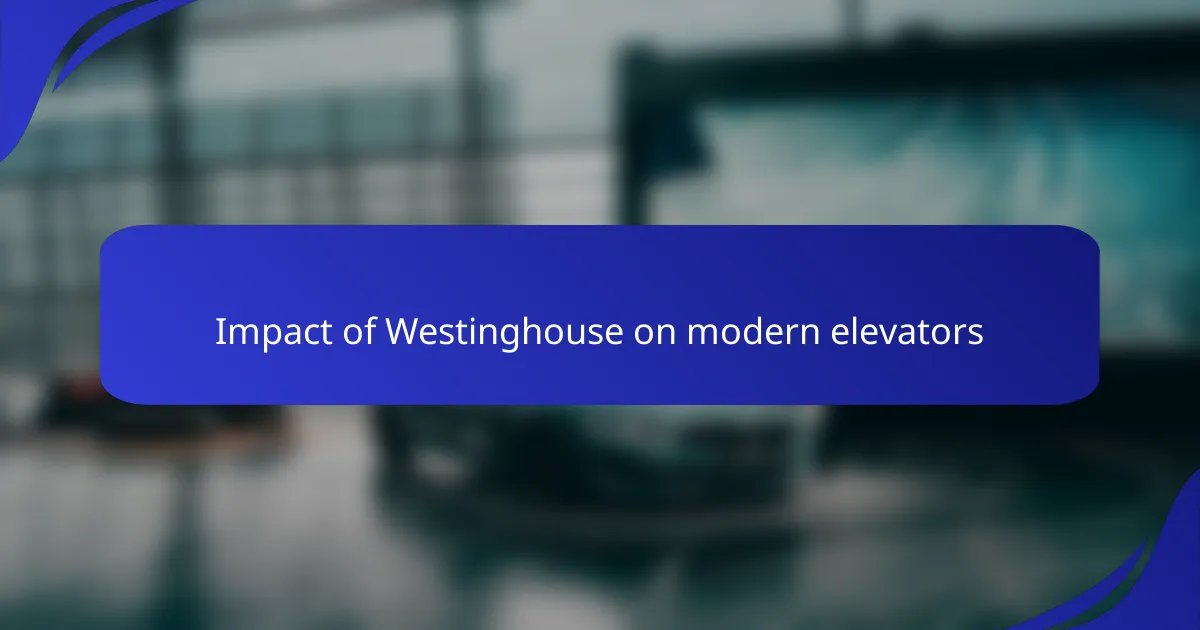
Impact of Westinghouse on modern elevators
The impact of Westinghouse on modern elevators is profound and far-reaching. I still recall my first ride in a Westinghouse elevator; the quiet hum and smooth ascent were unlike anything I had experienced. This early adoption of electric traction technology not only transformed vertical transportation but fundamentally shaped how buildings were designed. It makes me wonder: how many architectural masterpieces owe their existence to the innovations Westinghouse brought into play?
As I explored further, I found that their innovations extended beyond just mechanics. The automatic operation systems introduced in the 1920s were revolutionary. I remember thinking about how convenient it was to simply press a button and let the elevator do the work. It strikes me as extraordinary how Westinghouse made elevators more accessible to everyone, removing the barriers of manual operation. They effectively democratized vertical travel, which is something we often take for granted today.
In the 1980s, the integration of microprocessors took things to a new level. Reflecting on this, I realize these advancements have paved the way for smarter, more efficient elevators that we rely on daily. It’s fascinating to consider how much we now expect from these machines—from real-time data tracking to energy efficiency. Each innovation I uncovered reminded me of the legacy of Westinghouse: a commitment not only to safety and efficiency but to enhancing the overall human experience in vertical transportation. What a journey it has been!
